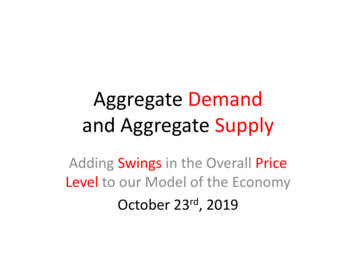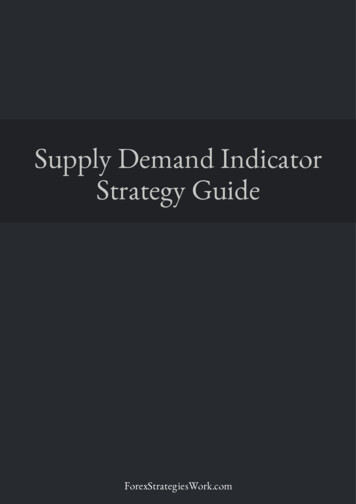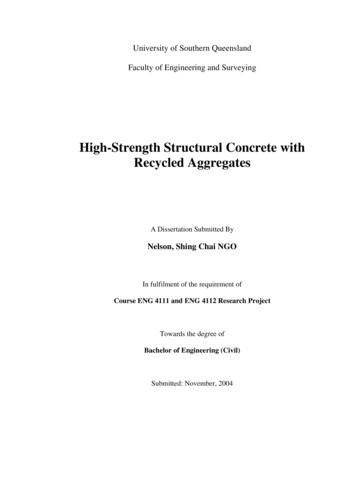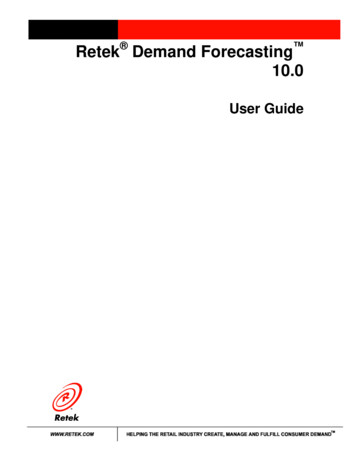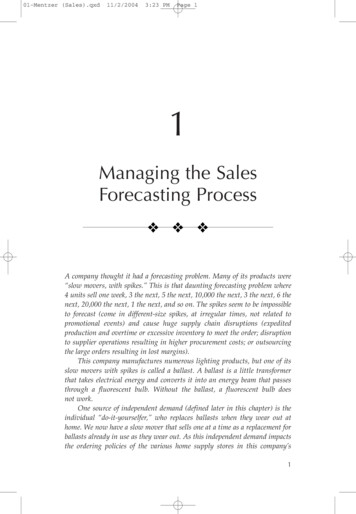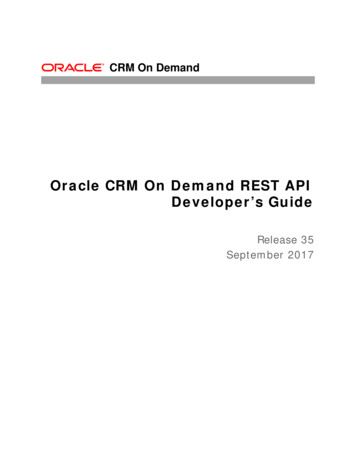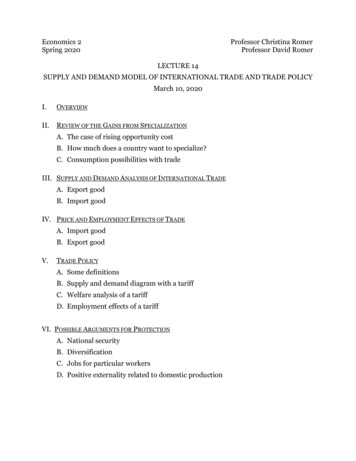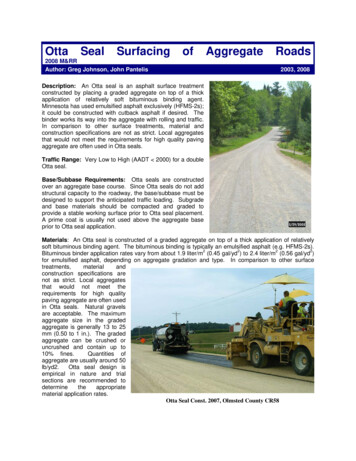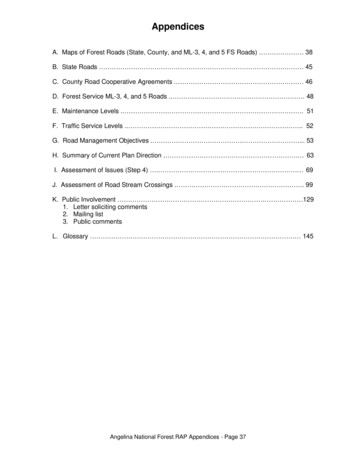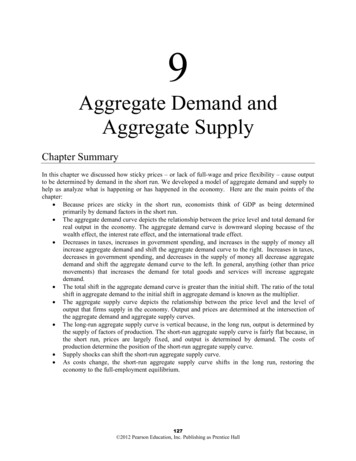
Transcription
9Aggregate Demand andAggregate SupplyChapter SummaryIn this chapter we discussed how sticky prices – or lack of full-wage and price flexibility – cause outputto be determined by demand in the short run. We developed a model of aggregate demand and supply tohelp us analyze what is happening or has happened in the economy. Here are the main points of thechapter: Because prices are sticky in the short run, economists think of GDP as being determinedprimarily by demand factors in the short run. The aggregate demand curve depicts the relationship between the price level and total demand forreal output in the economy. The aggregate demand curve is downward sloping because of thewealth effect, the interest rate effect, and the international trade effect. Decreases in taxes, increases in government spending, and increases in the supply of money allincrease aggregate demand and shift the aggregate demand curve to the right. Increases in taxes,decreases in government spending, and decreases in the supply of money all decrease aggregatedemand and shift the aggregate demand curve to the left. In general, anything (other than pricemovements) that increases the demand for total goods and services will increase aggregatedemand. The total shift in the aggregate demand curve is greater than the initial shift. The ratio of the totalshift in aggregate demand to the initial shift in aggregate demand is known as the multiplier. The aggregate supply curve depicts the relationship between the price level and the level ofoutput that firms supply in the economy. Output and prices are determined at the intersection ofthe aggregate demand and aggregate supply curves. The long-run aggregate supply curve is vertical because, in the long run, output is determined bythe supply of factors of production. The short-run aggregate supply curve is fairly flat because, inthe short run, prices are largely fixed, and output is determined by demand. The costs ofproduction determine the position of the short-run aggregate supply curve. Supply shocks can shift the short-run aggregate supply curve. As costs change, the short-run aggregate supply curve shifts in the long run, restoring theeconomy to the full-employment equilibrium.127 2012 Pearson Education, Inc. Publishing as Prentice Hall
128O'Sullivan/Sheffrin/Perez, Macroeconomics, 7eApplying the ConceptsAfter reading this chapter, you should be able to answer these three key questions:1. What does the behavior of prices in consumer markets demonstrate about how quickly pricesadjust in the U.S. economy?2. How can we determine what factors cause recessions?3. Do changes in oil prices always hurt the U.S. economy?9.1 Sticky Prices and Their Macroeconomic ConsequencesWhat causes economic fluctuations? The price system serves as a coordinating mechanism in theeconomy. When prices and wages are flexible and adjust quickly, prices signal to markets what shouldand should not be produced. Equilibrium is restored and resources are efficiently allocated to their bestuse. But what if prices are not flexible and don’t adjust quickly? That is the issue with sticky prices.Sticky prices happen when prices don’t immediately adjust to changing market conditions. If prices arenot flexible and stick, then market coordination doesn’t work efficiently, causing economic fluctuations.Economic fluctuations are adjustments the economy makes as it returns to equilibrium. The fluctuationmay be an abnormal increase in production like an economic boom or an abnormal decrease in productionsuch as a recession.&Some of you drive a car with a manual transmission or a stick shift. Have you ever had a time whenyou get stuck in a gear or can’t find a gear to shift into? The gears grind. You can’t change speeds and, ifprolonged, start to slow down. The price system is like the gear mechanism in a car. When it movesfluidly and without sticking, then the car runs smoothly. The price system operates in a similar fashion.When it works, prices coordinate economic activity precisely. However, when prices stick like the gears,then the economy doesn’t allocate resources to their best use.Wages are often sticky as they don’t adjust immediately. Wage stickiness may be caused by unioncontracts or occupations that don’t change wages except once a year. Wage stickiness can be found in thewages of college professors and government workers, because their wages are set once a year regardlessof market conditions. Suppose that an automobile firm hires union workers under a contract that fixestheir wages for a specific period. If the economy suddenly thrives at some point during that period, theautomobile company will employ all the workers and perhaps require some to work overtime. If theeconomy stagnates at some point during that period, the firm will lay off some workers, using only part ofthe union labor force. Notice that demand for labor becomes the coordinating factor instead of the wages.Since a firm’s major input cost is wages, output prices may also remain sticky. In the short run, supplyand demand are hampered and may not reach equilibrium.0 Caution!Demand—not prices—drives the production of inputs and products in the short run.If the demand for inputs, such as labor or machines, is sustained over a long period of time, then pricesmay adjust to the new level of sustained demand. 2012 Pearson Education, Inc. Publishing as Prentice Hall
Chapter 9: Aggregate Demand and Aggregate Supply129To summarize, the short run in macroeconomics is the period in which prices do not change or do notchange very much. In the macroeconomic short run, both formal and informal contracts between firmsmean that changes in demand will be reflected primarily in changes in output, not prices.Let’s review an Application that answers one of the key questions we posed at the start of the chapter:1. What does the behavior of prices in consumer markets demonstrate about how quickly pricesadjust in the U.S. economy?APPLICATION 1: MEASURING PRICE STICKINESS IN CONSUMER MARKETSUniversity of Chicago economist Anil Kashyap investigated prices of various outdoor products. Hefound considerable price stickiness. Prices of the goods that he tracked such as shoes, blankets,chamois shirts, binoculars, and a fishing rod and fly were typically fixed for a year or more. MarkBils and Peter Klenow examined how frequently prices changed for 350 consumer goods. Theyfound that the prices of half of their goods lasted less than 4.3 months.& Another place where prices are sticky is at restaurants. Prices of restaurant meals don’t change toooften when economic changes occur. There are costs associated with changing menus. Those prices aresticky and don’t change when there is a change in the market. In that case, people demand what is on themenu and prices are not negotiated. Yet, not all prices are sticky. Sometimes there is some priceflexibility. Seafood such as lobster or crab have “market price” listed on the menu. The price of lobster orcrab may vary from day to day due to market conditions, but the menu cost didn’t change.9.2 Understanding Aggregate DemandIn this section, we develop a graphical tool known as the aggregate demand curve. Later in the chapter,we will develop the aggregate supply curve. Together the aggregate demand and aggregate supply curvesform an economic model that will enable us to study how output and prices are determined in both theshort run and the long run.Aggregate demand is the total demand for goods and services in an entire economy. In other words, it isthe demand for currently produced GDP by consumers, firms, the government, and the foreign sector.The aggregate demand curve (AD) shows the relationship between the level of prices and the quantityof real GDP demanded. Figure 9.1 shows an aggregate demand curve. The curve plots the total demandfor GDP as a function of the price level. RememberThe price level is the average price in the economy, as measured by a price index.The aggregate demand curve is downward sloping. As the price level falls, the total quantity demandedfor goods and services increases. As you studied in Chapter 5, consumption spending (C), investmentspending (I), government purchases (G), and net exports (NX) are the four parts of aggregate demand Theaggregate demand curve describes the demand for total GDP at different price levels.Price level changes cause changes in purchasing power throughout the economy. Recall the key principlefrom the book: 2012 Pearson Education, Inc. Publishing as Prentice Hall
130O'Sullivan/Sheffrin/Perez, Macroeconomics, 7eReal-Nominal PrincipleWhat matters to people is the real value of money or income—its purchasing power—not the face valueof money or income.There are three basic reasons for such purchasing power changes leading to changes in aggregate demand: The Wealth Effect: The wealth effect is an increase in spending that occurs because the realvalue of money increases when the price level falls. Lower prices lead to higher levels of wealth,and higher levels of wealth increase spending on total goods and services. When the price levelrises, consumers can’t simply substitute one good for another that’s cheaper, because at a higherprice level everything is more expensive. The Interest Rate Effect: With a given supply of money in the economy, a lower price level willlead to lower interest rates. With lower interest rates, both consumers and firms will find itcheaper to borrow money to make purchases. As a consequence, the demand for goods in theeconomy will increase. The International Trade Effect: Price level decreases will make domestic goods cheaper relativeto foreign goods. If domestic goods become cheaper than foreign goods, exports will increase andimports will decrease. Thus, net exports—a component of aggregate demand—will increase.What happens to the aggregate demand curve if a variable other than the price level changes? An increasein aggregate demand means that total demand for all the goods and services contained in real GDP hasincreased—even though the price level hasn’t changed. In other words, increases in aggregate demandshift the curve to the right.Conversely, factors that decrease aggregate demand shift the curve to the left—even though the pricelevel hasn’t changed.0 Caution!Anything affecting C, I, G, or NX other than the price level will cause shifts of theaggregate demand curve. Price level changes will cause movement along the aggregatedemand curve.The following are factors that cause changes in aggregate demand: Changes in the Supply of Money: At any given price level, a higher supply of money will meanmore consumer wealth and an increased demand for goods and services. A decrease in the supplyof money will decrease aggregate demand and shift the aggregate demand curve to the left. Changes in Taxes: A decrease in taxes will increase aggregate demand and shift the aggregatedemand curve to the right. An increase in taxes will decrease aggregate demand and shift theaggregate demand curve to the left. Higher taxes will decrease the income available tohouseholds and decrease their spending. Changes in Government Spending: At any given price level, an increase in governmentspending will increase aggregate demand and shift the aggregate demand curve to the right.Similarly, decreases in government spending will decrease aggregate demand and shift the curveto the left. All Other Changes in Demand: Increases in net exports will increase aggregate demand,shifting the curve to the right. Decreases in net exports will decrease aggregate demand, shiftingto the left. Other variables may increase or decrease aggregate demand. For example, 2012 Pearson Education, Inc. Publishing as Prentice Hall
Chapter 9: Aggregate Demand and Aggregate Supply131expectations of the future will cause changes in aggregate demand. If the future looks bleak, thenfirms may not want to expand and thus decrease private investment expenditures. Aggregatedemand would decrease, shifting the curve to the left. On the other hand, optimistic expectationsmay cause firms to expand and thus increase private investment expenditures. Aggregate demandwould increase, shifting the curve to the right.Figure 9.2 shows how aggregate demand curves shift and what causes changes in aggregate demand. Study TipTake some time to study Table 9.1 to know how different variables cause aggregatedemand changes.Take a look at Figure 9.3. Notice the total shift in the aggregate demand curve from a to c in Figure 9.3 isgreater than the initial shift in the curve from a to b. This is the multiplier in action. So what is themultiplier? The multiplier is the ratio of the total shift in aggregate demand to the initial shift inaggregate demand. In other words, an initial expenditure will generate additional spending. For example,suppose the government increases spending for government services such as education. Those serviceswill generate income for households. Households will wish to spend, or consume, part of that income,which will further increase aggregate demand. It is this additional spending by consumers, over and abovewhat the government has already spent, that causes the further shift in the aggregate demand curve.Figure 9.3 shows how the multiplier shifts aggregate demand.Knowing the value of the multiplier is important for two reasons: First, it tells us how much shocks to aggregate demand are amplified. Second, to design effective economic policies to shift the aggregate demand curve, we need toknow the value of the multiplier to measure the proper “dose” for policy.To understand how the multiplier works in detail, you need to understand the following equations:; Key EquationsConsumption Function: C Ca by, where Ca is autonomous consumption expenditures, bis the marginal propensity to consume (MPC), and y is income.MPC additional consumptionadditional incomeMPS additional savingadditional incomeMPC MPS 1Multiplier 11 - MPCAs stated in the Key Equations box, consumption expenditures can be broken into two pieces.Autonomous consumption spending is the part of consumption expenditures that does not depend onincome. The other term in the consumption function is spending that changes when income changes. The 2012 Pearson Education, Inc. Publishing as Prentice Hall
132O'Sullivan/Sheffrin/Perez, Macroeconomics, 7emarginal propensity to consume, or MPC, is the fraction of additional income spent on consumptiongoods. The remaining fraction of additional income is saved, and is called the marginal propensity tosave, or MPS.The multiplier is mainly a function of the MPC. The greater the MPC, the larger the multiplier. Thesmaller the MPC, the smaller the multiplier. Page 193 gives a good example of how to compute the MPCand MPS. Study TipRead carefully the example on pages 193–194 to understand how the multiplier works withan initial expenditure of 10 million.Table 9.2 illustrates how the multiplier impacts aggregate demand with an initial government expenditureof 10 million. This analysis is carried out until all income is spent. There is an easier way to calculatethe size of the multiplier. The last equation of the previous Key Equations box computes the size of themultiplier.9.3 Understanding Aggregate SupplyThe aggregate supply curve (AS) shows the relationship between the level of prices and the totalquantity of output supplied. To determine both the price level and real GDP, we need to combine bothaggregate demand and aggregate supply. Since prices are sticky in the short run but can be flexible in thelong run, we will be deriving two different AS curves to represent those conditions.There are two aggregate supply curves that we need to understand, the long-run aggregate supply curveand the short-run aggregate supply curve. They will both be used to analyze macroeconomic activity.The long-run aggregate supply curve is a vertical aggregate supply curve that represents the idea that inthe long run, output is determined solely by the factors of production and technology. The reason thecurve is vertical is based on the premise that a fully employed economy will produce a fixed amount ofoutput regardless of prices as shown in Figure 9.4.We combine the aggregate demand curve and the long-run aggregate supply curve in Figure 9.5. Theintersection of an aggregate demand curve and an aggregate supply curve determines the price level andequilibrium level of output. At that intersection point, the total amount of output demanded will just equalthe total amount supplied by producers—the economy will be in macroeconomic equilibrium. Study HintIn the long run, aggregate demand only determines the price level. The level of output iscompletely determined by the quantities of factors of production and the productiontechnology available in the economy.In the long run, an increase in aggregate demand will raise prices but leave the level of output unchanged.In general, shifts in the aggregate demand curve in the long run do not change the level of output in theeconomy, but only change the level of prices. 2012 Pearson Education, Inc. Publishing as Prentice Hall
Chapter 9: Aggregate Demand and Aggregate Supply133 RememberIn the long run, output is determined solely by the supply of human and physical capitaland the supply of labor, not by the price level.Figure 9.6 shows the short-run aggregate supply curve (AS). The short-run aggregate supply curve is arelatively flat aggregate supply curve that represents the idea that prices do not change very much in theshort run and that firms adjust production to meet demand. The short-run aggregate supply curve has asmall upward slope. As firms supply more output, they increase prices only slightly due to sticky prices.We previously discussed that with formal and informal contracts firms will supply all the output that isdemanded with only relatively small changes in prices.The intersection of the AD and AS curves at point a0 determines the price level and the level of output.Because the aggregate supply curve is flat, aggregate demand primarily determines the level of output. InFigure 9.6, as aggregate demand increases, the new equilibrium will be at a slightly higher price, andoutput will increase from y0 to y1.Let’s review two Applications that answer key questions we posed at the start of the chapter:2. How can we determine what factors cause recessions?APPLICATION 2: TWO APPROACHES TO DETERMINING THE CAUSES OFRECESSIONSRecessions can occur either because of a decrease in aggregate demand, or a decrease inaggregate supply. Determining which of these caused a particular recession is a challenge.Economists have two primary approaches. One uses economic models and recognizes thatdemand shocks should only affect prices in the long run, while supply shocks affect output in thelong run. Other economists use historical methods to understand what caused a particularrecession.3. Do changes in oil prices always hurt the U.S. economy?APPLICATION 3: HOW THE U.S. ECONOMY HAS COPED WITH OIL PRICEFLUCTUATIONSBetween 1997 and 1998, the price of oil on the world market fell from 22 a barrel to less than 13 a barrel. The result was that gasoline prices, adjusted for inflation, were lower than they hadever been in over 50 years. In 2008, oil prices shot up to 145 a barrel, largely because ofincreased demand throughout the world, particularly in fast-growing countries such as China andIndia. Gasoline prices exceeded 4 a gallon. The economy had been weak prior to theseincreases, and policymakers feared the negative effects this major supply disturbance would haveboth on inflation and GDP.Supply shocks are external events that shift the aggregate supply curve. Figure 9.7 illustrates an adversesupply shock that raises prices. The short-run aggregate supply curve shifts up with the supply shockbecause firms will supply their output only at a higher price. The AS curve shifts up, raising the pricelevel and lowering the level of output from y0 to y1. Adverse supply shocks can therefore cause a fall inreal output with increasing prices. This phenomenon is known as stagflation. 2012 Pearson Education, Inc. Publishing as Prentice Hall
134O'Sullivan/Sheffrin/Perez, Macroeconomics, 7e9.4 From the Short Run to the Long RunIn Figure 9.8, we show the aggregate demand curve intersecting the short-run aggregate supply curve atan output level y0. We also depict the long-run aggregate supply curve in this figure. The level of outputin the economy, y0, exceeds the level of potential output, yp. In other words, this is a boom economy:Output exceeds potential output. RememberPotential output is the output level produced by a full-employment economy. Study TipThe only way to get better at graphs is to draw them. You should draw and label this graphenough times that it becomes comfortable to you.What happens during a boom? Because the economy is producing at a level beyond its long-run potential,the level of unemployment will be very low. This will make it difficult for firms to recruit and retainworkers. As firms compete for labor and raw materials, the tendency will be for both wages and prices toincrease over time. Increasing wages and prices will shift the short-run aggregate supply curve to the left.Figure 9.9 shows how the short-run aggregate supply curve shifts upward over time. As the economyadjusts, there will be continuing competition for labor and raw materials that will lead to continuingincreases in wages and prices. The reason there may be more than one short-run equilibrium, as theeconomy moves to the long run, is due to sticky prices.In the long run, the short-run aggregate supply curve will keep rising until it intersects the aggregatedemand curve at a1. At this point, the economy reaches the long-run equilibrium—precisely the pointwhere the aggregate demand curve intersects the long-run aggregate supply curve.&In this model, the long-run aggregate supply function acts like an attracting magnet. The short-runcondition may move away from the long-run equilibrium, but will be attracted by economic forces backto long-run equilibrium.In summary:If y0 y p, unemployment wages and prices short run AS y to y y pIf y0 y p, unemployment wages and prices short run AS y to y y pActivityCalculate the multiplier for the following MPC and MPS information:a. MPC 0.6b. MPC 0.75c. MPC 0.8d. MPS 0.1e. MPS 0.5f. MPS 0.8 2012 Pearson Education, Inc. Publishing as Prentice Hall
Chapter 9: Aggregate Demand and Aggregate y TermsAggregate demand curve (AD): A curve that shows the relationship between the level of prices and thequantity of real GDP demanded.Aggregate supply curve (AS): A curve that shows the relationship between the level of prices and thequantity of output supplied.Autonomous consumption spending: The part of consumption spending that does not depend on income.Consumption function: The relationship between the level of income and consumer spending.Long-run aggregate supply curve: A vertical aggregate supply curve that represents the idea that in thelong run, output is determined solely by the factors of production and technology.Marginal propensity to consume (MPC): The fraction of additional income that is spent.Marginal propensity to save (MPS): The fraction of additional income that is saved.Multiplier: The ratio of the total shift in aggregate demand to the initial shift in aggregate demand.Short run in macroeconomics: The period of time in which prices do not change or do not change verymuch.Short-run aggregate supply curve: A relatively flat aggregate supply curve that represents the idea thatprices do not change very much in the short run and that firms adjust production to meet demand.Stagflation: A decrease in real output with increasing prices.Supply shocks: External events that shift the aggregate supply curve.Wealth effect: The increase in spending that occurs because the real value of money increases when theprice level falls. 2012 Pearson Education, Inc. Publishing as Prentice Hall
136O'Sullivan/Sheffrin/Perez, Macroeconomics, 7ePractice Quiz(Answers are provided at the end of the Practice Quiz.)1. According to Keynesian analysis,a. wages adjust rapidly and this causes prices to rapidly change as well.b. wages adjust slowly and this causes prices to rapidly change in compensation.c. wages adjust slowly and this causes prices to slowly change as well.d. wages adjust rapidly and this causes prices to slowly change in compensation.2. An economy is more likely to avoid economic fluctuations ifa. prices adjust slowly.b. prices adjust quickly.c. prices don’t send signals to producers and consumers.d. prices prevent economic coordination.3. Which of the following statements is correct?a. Flexible wages lead to sticky prices and hamper the economy’s ability to bring demand andsupply into balance in the short run.b. Sticky wages cause sticky prices and hamper the economy’s ability to bring demand and supplyinto balance in the short run.c. Sticky wages and sticky prices are an important aspect of economic stability, bringing demandand supply into balance in the long run.d. In order to bring supply and demand into balance in the long run, flexible wages and prices mustbecome sticky wages and prices.4. According to the textbook discussion of the macroeconomic consequences of sticky prices, in themacroeconomic short run, both formal and informal contracts between firms mean thata. changes in supply will be reflected primarily in changes in prices, not output.b. changes in demand will be reflected primarily in changes in output, not prices.c. changes in supply and demand will be reflected in changes in prices, not output.d. changes in factors other than supply and demand will be reflected in changes in output, not prices.5. Which components of GDP are also components of aggregate demand?a. consumption and investmentb. government spending and net exportsc. all of the aboved. none of the above6. The increase in spending that occurs because the real value of money increases when the price levelfalls is calleda. the wealth effect.b. the interest rate effect.c. the foreign trade effect.d. the income effect. 2012 Pearson Education, Inc. Publishing as Prentice Hall
Chapter 9: Aggregate Demand and Aggregate Supply1377. A higher domestic price level will result ina. higher imports.b. higher exports.c. probably both higher imports and higher exports.d. higher net exports.8. Refer to the figure below. An increase in government spending, all else the same, will shift the ADcurve from the initial AD curve to the curve labeleda.b.c.d.Increased AD.Decreased AD.Neither curve. Government spending does not affect the AD curve.Either curve, depending on the simultaneous changes in taxation.9. Refer to the figure below. Which of the following best represents the impact of a decrease ingovernment spending through the multiplier process?a.b.c.d.the shift from a to b, and then to cthe shift from b to c, and back to athe shift from b to a, and then to cthe shift from c to b, and then to a10. Consider the consumption function C Ca bY. Which part of this function is called the autonomousconsumption spending?a. Cab. bc. bYd. Ca bY 2012 Pearson Education, Inc. Publishing as Prentice Hall
138O'Sullivan/Sheffrin/Perez, Macroeconomics, 7e11. The aggregate supply curve depicts the relationship betweena. the number of firms in the economy and the corresponding level of output produced.b. the level of prices and the total quantity of final goods and services that firms are willing and ableto supply.c. the number of firms in the economy and the corresponding level of prices.d. the number of firms, the number of workers, and the quantity of final goods that both firms andworkers together can supply to the entire economy.12. In the long run, the level of output isa. independent of the price level.b. dependent solely on the supply factors.c. the full-employment level of output.d. all of the above13. In the short run, lower aggregate demand will causea. a large decrease in the price level, but no change in the level of output.b. a lower price level, but only a slight decrease in the level of output.c. a lower level of output, but only a slight decrease in the price level.d. a large decrease in both the price level and the level of output.14. Refer to the figure below. The situation of this economy after the supply shock can be calleda.b.c.d.insufficient demand.economic growth.stagflation.excess supply. 2012 Pearson Education, Inc. Publishing as Prentice Hall
Chapter 9: Aggregate Demand and Aggregate Supply13915. Refer to the figure below. In this economy there will be a tendency fora.b.c.d.prices to fall and wages to rise over time.prices to rise and wages to fall over time.both wages and prices to rise over time.both wages and prices to fall over time.16. This question tests your understanding of Application 1 in this chapter: Price stickiness in retailcatalogs. What does the behavior of prices in retail catalogs demonstrate about how quickly pricesadjust in the U.S. economy?To analyze the behavior of retail prices, economist Anil Kashyap of the University of Chicagoexamined prices in consumer catalogs. Kashyap tracked several goods over time, including severalvarieties of shoes, blankets, chamois shirts, binoculars, and a fishing rod and fly. He found thata. the prices of the goods he tracked changed substantially over time. There was considerable priceflexibility.b. when prices did change, the changes were always relatively small.c. prices of the goods that he tracked were typically fixed for a year or more.d. during periods of high inflation, prices tended to change less frequently.17. Describe the phenomenon of economic fluctuations and articulate Keynes’s opinion of the causes thatled to the Great
The aggregate supply curve depicts the relationship between the price level and the level of output that firms supply in the economy. Output and prices are determined at the intersection of the aggregate demand and aggregate supply curves. The long-run aggregate supply curve is vertical because, in the long run, output is determined by
